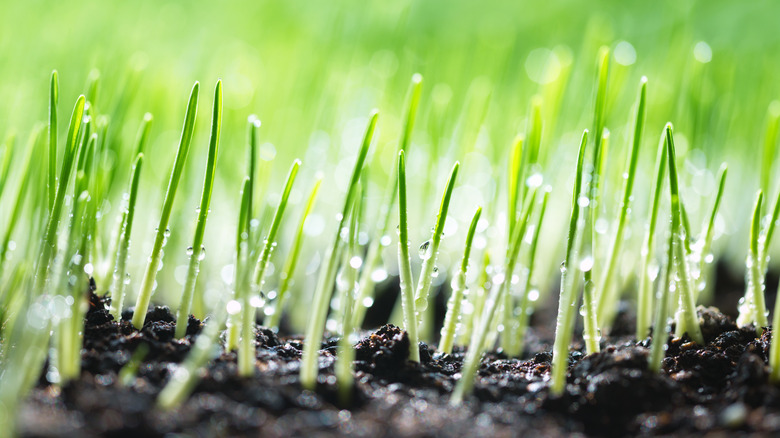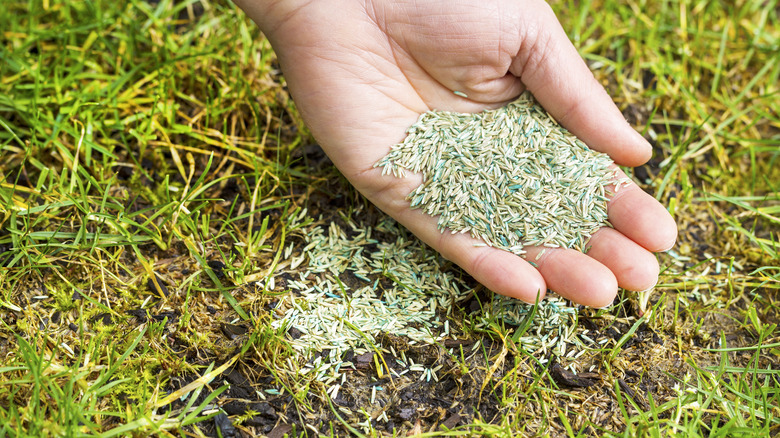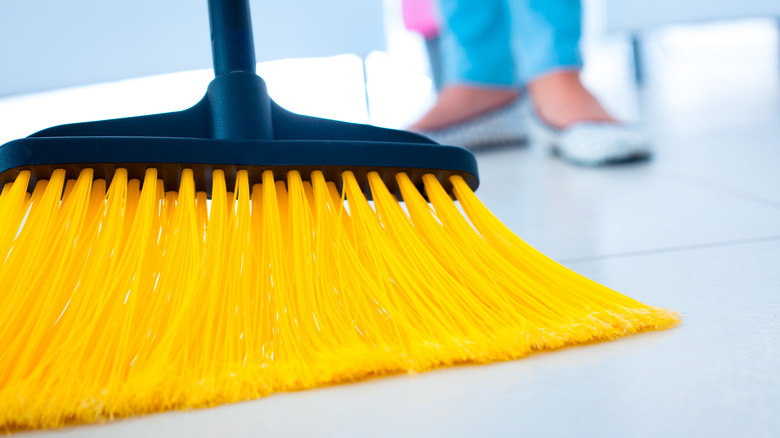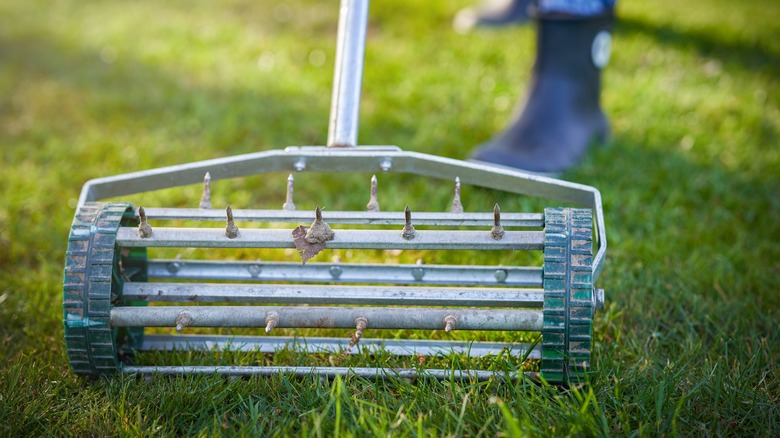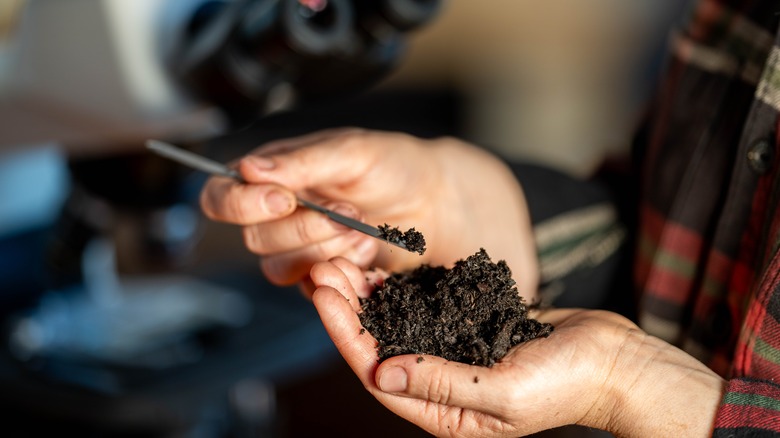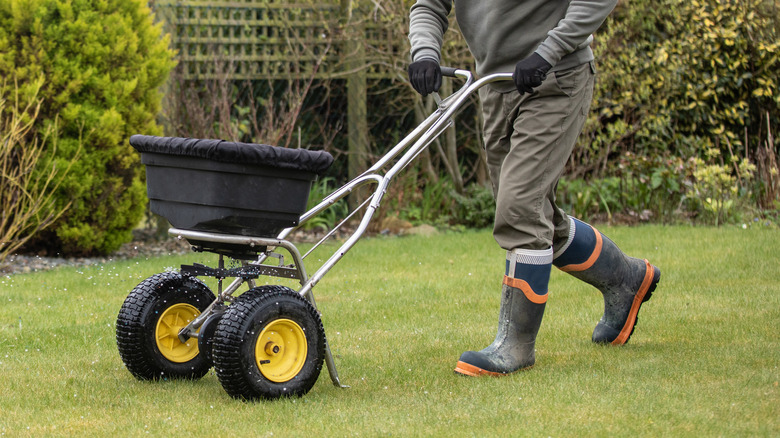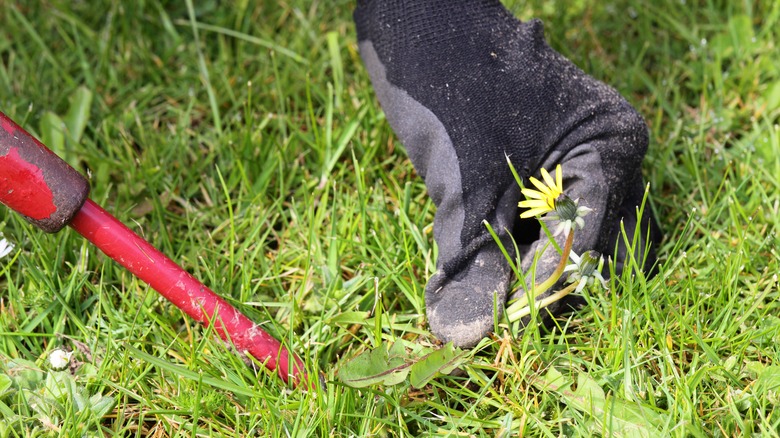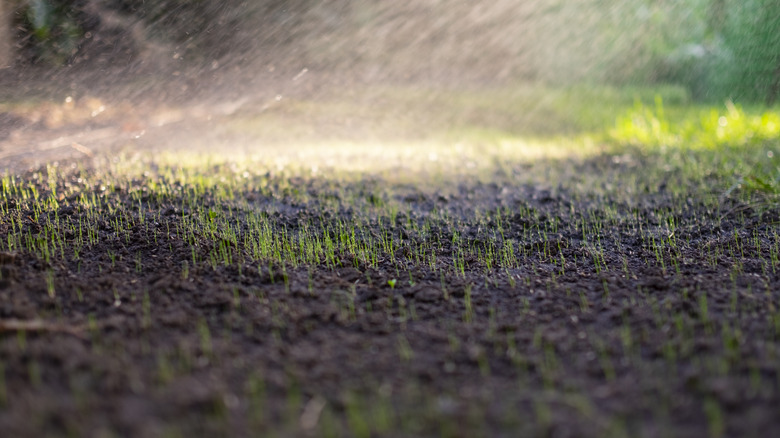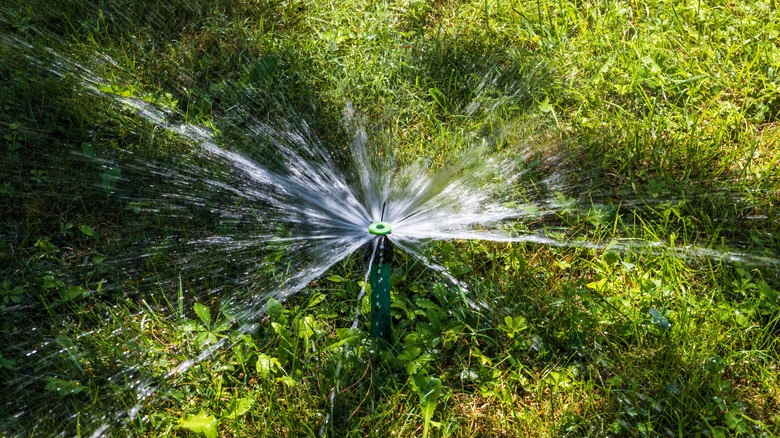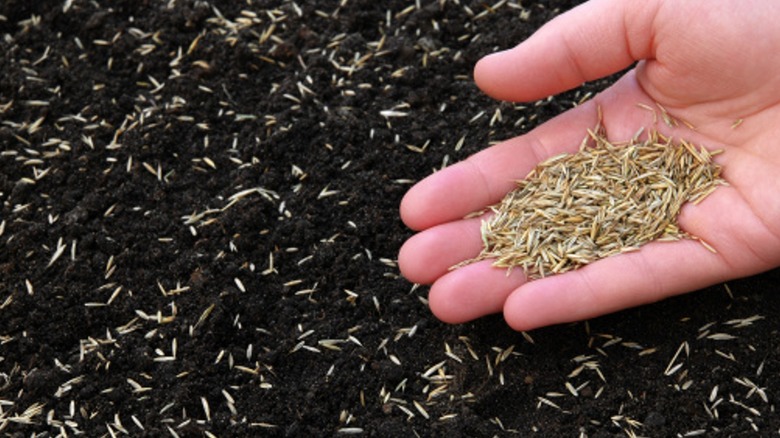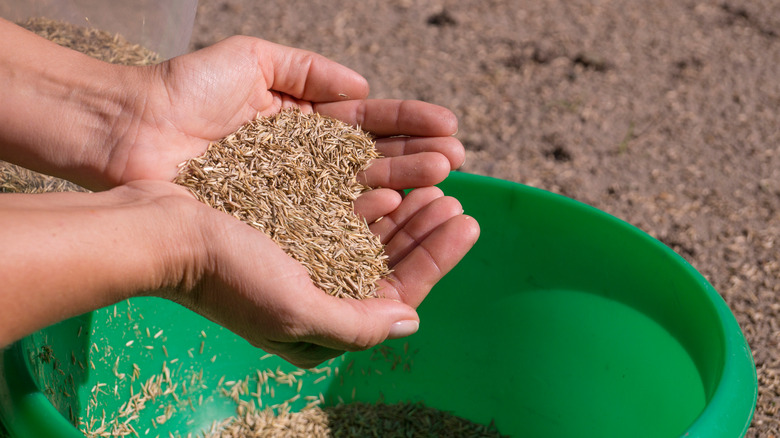10 Tips & Tricks For Growing Grass From Seed
We may receive a commission on purchases made from links.
Many of us long for a perfectly manicured lawn. However, our yards often have other things in mind, leaving us with unsightly bare spots or patches of dying grass. Planting some new grass seed can solve these — and other — problems, but only if you know how to grow it properly. If not sowed or cared for the right way, the grass seed you plant may not actually germinate or grow. This will prevent you from being able to clean up those unsightly spots, or even a fully bare lawn.
The good news is that growing grass from seed doesn't have to be a guessing game. It is something that many have perfected with trial, error, and experience. You can benefit from the tips and tricks shared below, taking the guesswork out of the equation and allowing you to achieve the lawn you've always longed for. Read on to learn how to increase the chances that your grass seed will grow as desired.
Pre-germinate the seeds
Did you know that you can pre-germinate grass seed before planting it? If not, you're not alone. Many people don't know this trick, which may at least partially explain why some run into such issues when trying to grow grass. Pre-germinating the seeds will add a few initial steps, but it will be worth it when the seeds actually sprout. With pre-germination, the seeds are more likely to remain in place, instead of getting washed or blown away by rain and wind, or eaten by animals. Plus, with pre-germination, the new grass seed won't require as much water during those first crucial few days.
If you want to pre-germinate your seeds, you can start by preparing the section of your yard in the same way that you would before sowing seeds in the traditional manner. Then, measure out the seeds you'll need for the area you want to cover, and place them in a large burlap sack or cheesecloth. Place the bag of seeds in a clean bucket (or split it between multiple buckets, if necessary) and add enough water to submerge all the seeds. Move the bucket to a location where the temperature will stay between 65 and 72 degrees Fahrenheit, and change the water one to two times each day. Look up the germination time for the type of grass seed you have and allow it to soak for that period of time. Once the recommended soaking period has passed, drain the seeds and mix them with some lawn food before spreading them over the desired area.
Run a broom over the seeds after you lay them down
Another way you can help increase the odds that your grass seed will sprout and grow as desired is to use a tool that you probably have in your kitchen right now (though you'll probably want to get a new one just to use outside). Running a broom over the seeds can offer several benefits. First, the broom will help ensure that the seeds are more evenly distributed over the area and that any clumps that were inadvertently left are spread out.
Second, when you broom over grass seed, it will also help push them farther down into the soil than would otherwise be achieved when spreading by hand or with a mechanical spreader. With the seeds deeper in the soil, birds will be less likely to steal a snack. Moreover, it will be more likely that the seed will germinate and grow properly.
Aerate the soil before seeding
Before you spread any seeds over your lawn, don't skip the crucial task of aerating the soil. Aeration delivers several benefits to the soil itself. First, it helps loosen and break up soil that has become compacted over time. It also introduces more air into the soil, helping it breathe.
Aerating the soil can be particularly beneficial when planting grass seed. When the soil is loosened up, it will be easier for the seeds to germinate, sprout, and eventually grow. Moreover, when you aerate the soil, beneficial microbes are transferred up from beneath the surface, allowing them to help create ideal growing conditions for the grass.
Aerating before overseeding or seeding a lawn for the first time is just generally a good practice, but there are also some signs that can help you know that it is especially important for your yard. If you're seeing pooling water, that is an indication that the soil is too compacted to effectively absorb it and signals that aeration is necessary. The best time to aerate is in the fall. However, if you are planning on seeding in the spring, you can aerate at that time as well.
Test the soil before seeding
As you're thinking about preparing your soil for planting grass seed, don't overlook the importance of testing the soil. You can purchase soil test kits — such as the MySoil Soil Test Kit — online or at a local lawn and garden shop. These kits can help you determine your soil's pH level, as well as the levels of other essential nutrients, such as nitrogen, potassium, phosphorus, calcium, sulfur, and iron. After collecting the sample, you mail the kit to the lab for analysis.
Once you receive your results, you can evaluate the needs of your soil and make changes to help ensure your grass seed grows. Some testing kits even provide you with recommendations for the best fertilizers and other additives for your soil based on the specific nutrient and pH levels that were detected. Once you take steps to improve your soil, you can be more confident that you'll be able to successfully grow grass.
Fertilize the lawn properly
Knowing how and when to fertilize new seed is important. Fertilizer adds nutrients to the soil to make it healthier and enhance the growth of the grass. However, it is important to follow fertilization recommendations to avoid over-fertilizing, which can cause the new grass to become overgrown and weak, or even impact local waterways.
As you're planning your fertilizing schedule, keep in mind that the first round of fertilizer should actually be applied before you even lay the seed down. However, you don't want to pick up just any bag of fertilizer from your local garden shop. It is important to use a fertilizer specifically formulated for this task with some extra phosphorus and quick-release nitrogen. It should be labeled as a starter fertilizer. Then, apply a round of standard fertilizer between four and eight weeks after planting the seeds.
Remove weeds before seeding
Some wonder whether they should pull weeds before planting new grass seed. The answer to this question is pretty straightforward: It is best to get rid of any weeds that are invading the space before seeding your lawn. Leaving the weeds to deal with later will be a mistake. They take up space and consume resources that you want to leave for the new grass seeds. When you take time to remove the weeds before planting grass seed, there will be less competition for nutrients, and the grass will have a better shot at success.
Ideally, you'll want to plan ahead and treat for weeds a few weeks before you intend to plant the seeds. This will give the weed killers time to work and leave you with plenty of time to pull the weeds out of the ground. Just make sure when you remove them that you pull out the entire root system. If the roots aren't all removed, the weeds will be back in no time.
Cover the new seeds
While you could try to skip covering the new grass seed that you've planted, you're just going to decrease the chances of the grass seed germinating and sprouting. There are a few reasons to cover grass seed. First, when the seeds are covered, they'll stay damp for a longer period of time. When less water evaporates and they stay moist, it will support germination and growth. If a heavy rainstorm comes through, covered seeds are less likely to wash away than uncovered ones. Plus, with a layer between the seeds and birds, fewer seeds will be eaten before they have a chance to do anything.
There are different types of seed cover you can use. Straw is one option. In addition to being affordable, straw is easy to distribute over the grass seed. It works well at retaining water and protecting the seeds from birds and heavy rains. You can also find mulch and fertilizer mixes specifically formulated for this task, but they will be more expensive.
Take care when watering
When watering new grass seed, you must walk the thin line between not enough and too much water. If you deprive the seeds of the water they need, then they, obviously, won't sprout and grow. And, if they do, the grass isn't going to be as hearty as it could be. Too much water also isn't a good thing. If you saturate the ground or spray the seeds with too much force, you run the risk of them getting washed away. Moreover, overwatering can also soften the soil to the point that it sinks as you walk across it, leaving indentations all over your lawn from your shoes.
So, just how much water does new grass seed need? You'll want to make sure you water the new seeds about two times every day, unless there is rain in the forecast. However, each watering session should only last about 10 minutes, so either set a timer for yourself or purchase an automatic sprinkler timer, such as the Rainpoint Sprinkler Timer, to take care of everything for you. Continue watering the new seeds two times each day until about a week after they have sprouted. Then, cut back watering to only once a day for a few more weeks, or as needed, based on the weather.
Get your timing right
If you want to give your grass seed the best shot at growing, then you can't simply spread it at any point during the year. Choosing the best time is key to the success of the new grass. Unfortunately, there isn't one "best" month or day to plant grass. It will vary based on where you live and the type of grass you want to grow.
If you live in a warmer climate and are planting St. Augustine grass, Zoysia grass, Bermuda grass, or other warm-season grasses, then you should plan to plant the seeds in late spring or early summer. This time of year is ideal for these grasses because they grow best in warm soil, and soil temperatures will be in the ideal 65 to 70 degrees Fahrenheit range during the summer. The exact planting time will vary based on your specific location. Be sure to wait until the soil has had some time to warm up after cooler winter temperatures and that there is no risk of frost before you plant.
If you live in a northern region where cool-season grasses do best, you'll find that early fall is the best time of the year to plant. During this time, the soil still retains some warmth from the hotter summer months, but the daytime temperatures are more moderate to help the new seeds germinate and grow. Unlike warm-season grasses, cool-season grasses thrive when the soil temperature is between 50 and 60 degrees Fahrenheit.
Choose the right type of grass seed
As alluded to above, the best type of grass seed varies based on where you live. Those in northern regions, where fall and winter temperatures are considerably colder than temperatures during the summer, will want to choose a cool-season grass. Cool-season grasses grow well in the more temperate spring and fall seasons and are able to survive through the colder winters. When temperatures are very hot during the summer, their growth will slow. A few examples of cool-season grasses include fine fescue, tall fescue, Kentucky bluegrass, and ryegrass.
Those in the southern regions of North America have the best success with warm-season grasses, such as Bahia grass, St. Augustine grass, and Bermuda grass. These grasses are able to thrive when temperatures are hot in the summer and still do well with temperate fall and winter temperatures. However, they are not suited for the cold winters of the north.
